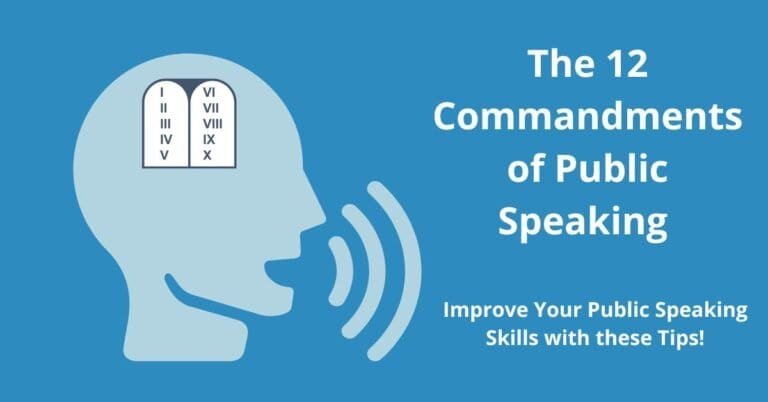The Importance of Rehearsal in Public Speaking: 7 Effective Rehearsal Techniques
Rehearsal in public speaking is one of the keys to provide a great presentation performance. Rehearsing your material is key in order to give you familiarity with your material and fueling your confidence.
Efficient rehearsal is the bridge between preparation and confident delivery in public speaking. It will make you feel more secure and relaxed with your performance, helping you avoid getting blanks and tripping on the phrases.
Sometimes executives feel strange about rehearsing. We’re not actors, are we? But one thing’s for sure: rehearsing leads to more confidence.
Let me tell you a personal experience…
A personal experience about rehearsing
Let me tell you a little story about my personal experience: I used to feel silly rehearsing a presentation on a stage. Speaking to thin air and pretending there were people listening felt like a madman’s activity to me. Of course, I used to do my “mental rehearsals”, but I didn’t like to do it on stage. It seemed to be enough.
Before doing my first presentation to a big audience as Aftersales Manager for Honda in Argentina, the new president made us rehearse the presentation on stage. He didn’t know us, so he wanted to see how well we performed, and to make us feel sure about what we were going to say.
As I was doing it, I found pieces of content that, as good as they sounded in my mind, didn’t feel right to me as I was telling them aloud. My tongue was tripping on some words, some phrases didn’t link that well with each other.
I found maybe rephrasing them a bit felt more natural to me, so I felt more secure while I was telling them. I felt more familiar with my material. And when I finally gave my speech, it was fluid and vivid, and it was really convincing for my audience. I got more supporters that I ever expected to have.
So I never stopped rehearsing my material on stage after that. Even when the president didn’t care anymore about hearing it beforehand, because he was confident enough that I would do well on the stage.
Best Rehearsal Techniques for your presentation:
Let’s discover some rehearsal techniques to ensure your practice is not just quantity but quality:
1. Chunking and Memorization:

Chunking is a valuable rehearsal technique that can significantly enhance your public speaking skills. It is a cognitive process that involves breaking down complex information into smaller, more manageable segments or “chunks.” When applied to public speaking, this technique helps you organize and remember the key points of your speech.
Here’s how it works:
Dividing Content:
Begin by dividing your speech into distinct sections or chunks. Each chunk should represent a main point, idea, or topic. By breaking your speech into smaller units, you make it easier to digest and remember.
Focus on One Chunk at a Time:
When rehearsing, concentrate on one chunk at a time. This focused approach allows you to thoroughly understand and memorize the content within each segment before moving on to the next.
Repeat and Connect:
Practice each chunk repeatedly until you can deliver it confidently without relying heavily on notes or prompts. As you become comfortable with one chunk, gradually connect it to the previous one, forming a coherent flow for your entire speech.
Visual Aids:
You can also use visual aids, such as cue cards or slides, to reinforce the key points within each chunk. Visual cues can be especially helpful for triggering your memory during the actual presentation. This technique also helps you avoid reading your presentation, one of the most annoying practices for your audience.
By chunking your speech and memorizing it in this manner, you improve your overall recall and reduce the risk of forgetting important information during your presentation. This technique allows you to approach public speaking with greater confidence, knowing that you have a well-organized and memorized structure to rely on.
2. Verbal and Physical Repetition:
Verbal and physical repetition is about ingraining your speech in your memory and body, making you well-prepared and self-assured when facing your audience. It’s a technique that builds fluency, confidence, and effectiveness in public speaking.
Verbal Repetition:
In this aspect, you repeatedly practice your speech aloud. Begin by reading your speech verbatim to familiarize yourself with the content. Then, gradually reduce your reliance on the script until you can deliver the speech fluently from memory. Repeating the words and phrases helps you internalize the content and ensures you won’t get stuck during your presentation.
Physical Repetition:
This involves practicing your body language, gestures, and movements while delivering your speech. Repeatedly rehearsing how you’ll stand, move, and use gestures enhances your non-verbal communication skills. This, in turn, helps convey confidence and reinforces your message.
The next step is to combine both verbal and physical repetitions. The combination of verbal and physical repetition ensures that both your words and your body language align seamlessly during your presentation. This synchronicity not only enhances your message’s clarity but also boosts your confidence, as you’re well-practiced in both the content and delivery.
3. Visualization:

Before physically rehearsing, visualize yourself delivering the speech flawlessly. Envision the stage, the audience, and your confident demeanor. This mental rehearsal enhances your familiarity with the content.
Here’s how it works:
First, you do a Mental Rehearsal. Find a quiet space to close your eyes and vividly visualize yourself giving your speech. Imagine the details—the stage, the audience, your body language, and your confident tone. Envision yourself smoothly transitioning between points and handling questions with ease.
As a second step, during your mental rehearsal, focus on positive outcomes. Picture the audience engaged and responsive, nodding in agreement with your points. See yourself finishing your speech to applause and receiving compliments afterward.
Last but not least, engage your emotions during visualization. Feel the excitement and satisfaction of delivering a successful speech. This emotional connection reinforces your confidence and reduces anxiety.
Visualization helps reduce anxiety, increase confidence, and improve overall performance. It’s a tool that mentally prepares you for success and empowers you to step onto the stage with confidence and composure.
4. Record and Review:

This is a difficult one… not everybody likes to see themselves on the screen, and watching at all the mistakes they’ve done while performing. But recording and reviewing your presentation is a fundamental technique to enhance your public speaking skills.
This method involves recording your practice sessions or actual presentations, then critically analyzing the footage to identify areas for improvement. Here’s how it can benefit your growth as a speaker:
Objective Self-Assessment:
Recording your presentations offers an objective view of your performance. It allows you to see and hear yourself from the audience’s perspective, highlighting strengths and areas that need work.
Identifying Weaknesses:
By reviewing the recordings, you can pinpoint specific issues like verbal tics, body language habits, or pacing problems that you might not have noticed during practice.
Refinement:
Armed with insights from the review, you can make targeted improvements in subsequent rehearsals. This iterative process helps you refine your content, delivery, and overall presentation.
Over time, the act of recording and reviewing your speeches builds confidence. As you see progress in your presentations, you gain assurance in your abilities.It also allows you to adapt to different speaking contexts and audiences, refining your approach for maximum impact.
It’s important not to be extremely critical with yourself. You have to accept your mistakes, not punishing yourself for them, but using them as tools to give a better performance.
5. Time Management:
Time management is a crucial aspect of effective public speaking. If you make your speech too short, you may not transmit your ideas. If you make it too long, you might lose your audience in the way.
Time Management of a presentation involves planning and allocating your available time wisely to ensure a well-paced and engaging speech:
The first thing you have to do is to Set Clear Time Limits. Begin by establishing the time limits for your presentation, taking into account any guidelines or expectations from your audience. This helps you structure your content appropriately.
You’ll also have to Outline Your Speech. Create a clear outline of your speech, breaking it into sections with estimated time allocations. Ensure that your introduction, main points, and conclusion fit within your allotted time.
Then you have to Practice Timing. During rehearsals, time yourself to see how your speech aligns with your intended duration. Adjust your pace and content as needed to stay within your time limit.
Always allow some time for Q&A. If your presentation includes a Q&A session, factor in time for this at the end. Be concise in your responses to stay on schedule.
Last, Prepare for Unexpected Delays. Plan for potential interruptions or technical issues that could affect your time management. Having contingency plans in place demonstrates professionalism.
Effective time management ensures that your audience remains engaged and that your message is delivered clearly. It also reduces anxiety, as you’ll have greater control over your presentation’s flow. By mastering this aspect of rehearsal, you enhance your overall public speaking skills.
6. Mock Audience in your rehearsal:

Utilizing a Mock Audience for Your Presentation Rehearsal is a highly effective technique for refining your public speaking skills. This strategy involves practicing your speech in front of a small group of individuals who simulate an actual audience.
Some of the benefits of this practice are:
It gives you a Realistic Feedback: A mock audience provides valuable feedback from diverse perspectives. They can offer insights on content, delivery, and overall impact, helping you identify areas for improvement.
Pressure Simulation: Practicing in front of others mimics the pressure of a live audience, helping you manage nerves and anxiety. It builds your confidence in handling real speaking situations.
Interaction Practice: It allows you to rehearse audience interaction, such as handling questions or engaging with different audience members. This makes you more adaptable during the actual presentation.
Timing and Pacing: Presenting to a mock audience helps you fine-tune your timing and pacing. You can gauge when to slow down, emphasize key points, or move on to the next topic.
Audience Engagement: Observing the reactions of your mock audience allows you to adjust your content and delivery to keep them engaged and attentive.
Incorporating a mock audience into your rehearsal process is a strategic step towards becoming a more effective and confident public speaker. Their feedback and the realistic environment they provide are invaluable in helping you refine your presentation before facing a live audience.
7. Impromptu Drill:
Occasionally, challenge yourself with impromptu practice. Choose a topic and speak on it spontaneously. This sharpens your ability to think on your feet—a vital skill in public speaking.
These drills involve spontaneously responding to unexpected topics or questions, helping you develop your improvisational skills. They improve your quick thinking and adaptability of your communication style and message. They also boost your confidence and enhace your verbal fluency, and help you make a better connection with your audience.
Some final words on Rehearsal in Public Speaking
As we have shown through this article, rehearsing is vital for your public speaking performance. It will help you to turn from an average speaker into a great one.
By incorporating these techniques into your rehearsal process, you not only enhance your memorization but also refine your delivery style. Practicing with intentionality transforms raw content into a polished, confident, and impactful presentation.
Don’t forget to check our article on “The 12 Commandments of Public Speaking” for more Public Speaking tips!
Hope to see you on stage soon!







